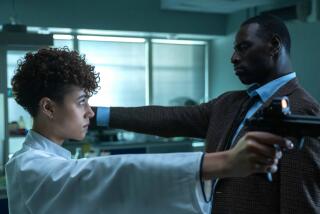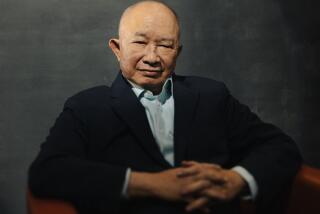For Carradine, kung fu didn’t end with show
- Share via
Before “Kung Fu” debuted on television, the martial art of the same name was something strange and exotic, practiced only by Asians who had studied intensely for years. But that changed when David Carradine appeared on the scene as a Shaolin priest who stood up to the bad guys while roaming the Old West, bringing kung fu to the masses in the process.
Today, 30 years later, various forms of kung fu are taught across the country, and elements of tai chi and other martial arts are incorporated into aerobics classes. Even Teresa Heinz Kerry, wife of presidential candidate John Kerry, publicly touts the benefits of tai chi. Martial arts may have lost their exotic cachet, but now millions of Americans are aware of their mental and physical health advantages.
Count Carradine among them. As much as the show fused martial arts to his persona, many people have no idea that the 67-year-old actor has continued to practice and teach kung fu and tai chi since studying it for the show, staying very much connected to these Eastern disciplines.
He is still revered by many in the martial arts field as the father of Western kung fu. He made the cover of Black Belt magazine in December and writes a wide-ranging monthly column about his life and martial arts for Inside Kung-Fu magazine. A multipart series of his instructional tai chi and kung fu videos is being re-released on DVD (for Naturaljourneys), and his role as the samurai-trained assassin Bill in the ultra-bloody “Kill Bill” Vols. 1 and 2 will introduce him to a new generation of martial arts fans. So will the release this month of the first season of “Kung Fu” on DVD.
Despite the decades of dedication, the man clearly does things his own way, both with kung fu, a Chinese combat martial art, and tai chi, a self-defense technique utilizing slow, steady movements that also are supposed to bring about relaxation and awareness of the body. Carradine is bored with basic foundation moves (“After a while you have to stop playing ‘Chopsticks,’ ” he says) and practices when the mood strikes, often incorporating moves when he’s alone or playing with his dog or grandkids. He doesn’t even meditate the traditional way, choosing to steal moments whenever appropriate.
Whatever the formula is, it seems to be working. His longish gray hair is thinning, and his face shows the wear of almost seven decades, but his body is lithe and agile as he walks through the Bistro Garden restaurant in Studio City, headed for a corner table. There is none of the stiffness that often besets men his age.
Ask why he’s stayed connected to martial arts for three decades, and he answers simply: “It feels good.”
He seems to quickly realize the three-word answer doesn’t nearly convey the true complexity of the relationship, and he continues: “I’ve done all kinds of physical things -- I was a middleweight boxer for a short period, I did weightlifting, I used to run seven miles every day, all these things to keep in shape. Most of them are not really fun, and they don’t go anywhere. Tai chi, kung fu, I don’t care if you do them all day long for the rest of your life, there will always be something further, something more. It’s enlightening, and you can’t get enlightened lifting weights.”
These days his training routine is more haphazard than it has been. His training partner and kung fu master of some 20 years, Rob Moses, recently moved to Hawaii, so Carradine doesn’t have the benefit of their weekly sessions.
According to Moses, Carradine served as the inspiration for his 9 Psalms Praying Mantis Martial Fitness System, an interpretive form of kung fu that incorporates pantomime-type motions of swimming or playing with a ball. Because Carradine isn’t especially interested in the rote movements that are the basis of martial arts, Moses had to come up with something else to challenge him.
“It was his birthday in 1999,” Moses recalls, “and I was supposed to meet with him, and I thought, what am I going to do with David? This is boring for him.” Out of that, 9 Psalms was born.
Carradine is still proud that “Kung Fu” didn’t present the ancient martial art as a cool tool for revenge. The point of kung fu, he believes, is not to fight, not even always to defend yourself, but what the art “gives to you -- the serenity, the confidence, the connections between your mind and body and spirit.”
He’s felt that way during and since “Kung Fu” and even through the sequel series “Kung Fu: The Legend Continues,” which ran from 1993 to 1996. That has helped cement his reputation in the martial arts arena, says Dave Cater, editor of Inside Kung-Fu magazine.
“The show had a message, and it wasn’t just shoot-’em-up,” says Cater. “There was a philosophy behind it. Everybody looks to him as almost the founding father of Western kung fu, and even when he’s not in the kung fu limelight, he’s always in the hearts and minds of kung fu practitioners.”
Carradine says he immediately connected with the extensive samurai training he did for “Kill Bill.” (Vol. 2 is scheduled for release in April.) He surprised himself, even enjoying the rigorous discipline and exacting moves that the art requires. The three months of preparation included exhausting daily doses of stretching, cardio workouts, samurai technique and wire-assisted acrobatics. At the end, the actor says, he felt like a lion. One scene shot outside a monastery required him to walk up and down some 100 steps over and over, take after take.
“So I’m running up the steps because I don’t want to waste time, and because I really don’t want all these Chinese guys to think they’re dealing with an old man,” he says, scooping up the last bits of his raspberry tart.
“I want to show them I can handle this. And at the end of the day I’m not the least bit tired, and I realized that 10, 20, 30 years ago I could not have done this. All the training I’ve done throughout my life, plus the training on the movie, has actually put me in a situation where I’m a better physical specimen than I was when I was 22 years old.
“I’m not trying to be a master,” he adds, “I’m just trying to find more of me, and it should be making you more of you.”
*
(BEGIN TEXT OF INFOBOX)
A discipline for body and mind
Of the martial arts, tai chi in particular can have several benefits for the body and the mind, says Los Angeles-based instructor Randall Unruh, who has been practicing the discipline for 29 years. He outlined a few:
Balance: Basic principles of tai chi help practitioners understand the way the body moves and how the bones and muscles relate to one another. “You become more aware of where you’re putting your foot. These things help people, especially as they age, develop a better sense of what they’re doing with their body.” It also can make people less prone to injury and falls. “We recognize that there are more than five senses,” he says, “that there are also internal senses.”
Flexibility: Even with the basic exercises, the upper and lower body go through a full range of motion in a slow, fluid manner. Continuing to do these movements helps keep the body flexible without straining it, which is why many people can carry on their practice into their later years.
Strength: Tai chi can be deceptive. Although some of the movements are slow and graceful, it takes muscle strength and control to do them, do them well and do them repetitively. “When you do one little [routine] for seven or eight minutes you’re exhausted, like you’ve been lifting heavy weights for 20 minutes. There’s a lot of hard work going on on the inside, while on the outside you keep it soft and supple.”
Posture: The body’s posture can improve through a combination of elements, including emphasis on proper alignment, an increase in muscle strength and balance, and the confidence that comes from being fit and aware of one’s body and its movement.


